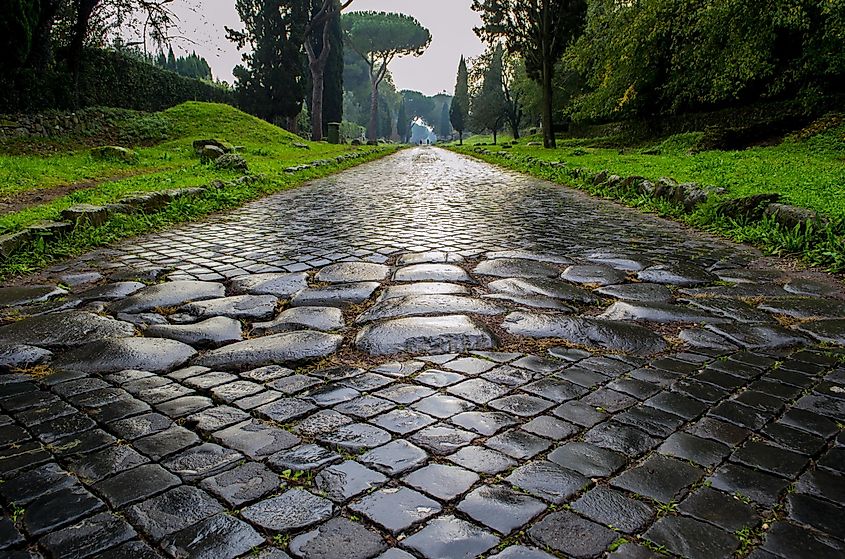
How Ancient Roman Roads Were Built
The Romans have left us with near-endless contributions. Many European languages stem from Latin, and much of the Western legal tradition and governmental structure can be traced back to the days of the early years of the republic. However, one of the most overlooked but enduring aspects of Roman life is their road network. The Romans were far from the first to build roads but were certainly the first to perfect them. The amount of engineering and planning that went into each roadway was truly staggering and did not get near the amount of attention that it deserves whenever Rome is studied or discussed.
Where Do All Roads Lead?

The Roman road network was the backbone of both the Roman Republic and the Roman Empire. Easy-to-use, well-built, and maintained roads meant that traveling across the vast Roman territory was relatively easy and straightforward. Merchants and traders could use the Roman highways to move between cities in record time and do so using horsedrawn carriages. This meant they could bring more goods with them to trade and sell. The easy flow of trade within the Roman territory was crucial to the state's economic prosperity.
The extensive road network also meant that Roman Legions would respond quickly to both external and internal threats. By the beginning of the 3rd century, Rome had finished expanding its borders, and its military took a much more defensive role. The legions were often called in to crush rebellions and local insurrections. Roads made all of this so much easier.
As invasions and raids became more common in the later years of the Empire, the roads and highways were paramount to move troops to breaches in the Roman border. While it did not stop the eventual collapse of Rome in Western Europe, it certainly played a large role in ensuring the Empire lasted much longer than it should have.
Roman Road-building Techniques

The Romans were master engineers. While it might not look like it at first glance, highways are just as much of a reflection of Roman genius and ingenuity as their famed aqueducts and baths. Each Roman road would usually begin with surveyors lighting a series of beacons heading in the direction they wished to build. This was not done with absolute precision, but it was rather meant as a way to roughly plot where the road was going to go. Once all of the beacons were in place, an engineer was usually called in along with his trusty groma.
A groma is a tool that was used for all manner of civil projects the Romans embarked on. It was made of a tall meter-long stick with two planks of wood lying horizontally across to make an "x" shape at the top. From the end of each plank of wood hung a line of string with a weight on end, making a plum line. The Roman operating the groma would use this tool to properly adjust the beacons that they had laid down previously. He would make sure that two plum lines lined up with one beacon and the other two lines lined up with the next beacon ahead. If they did not match up, the beacons were moved accordingly.
The Interstates Of The Ancient World
Once the tedious work of lining up all of the beacons was finished, the road construction could really begin. The Romans were insistent that each of the highways was wide enough to support the movement of thousands of troops and the constant wear and tear of wagons and other foot traffic.
Each road started out as a wide ditch and was gradually filled with a base layer of loose stones packed tightly together. Then a layer of logs cut in half was laid down for support. Then finally, a third layer of stone was added on top. The roads were all built with a slight curve at the top that was designed to direct rainwater to the sides of the road. This prevented pools of water from forming during bad weather and either damaged the roads permanently or rendered them unusable.
A Soldier's Life

The actual building process was particularly brutal and backbreaking work. Much of the roads, especially in the lesser developed areas of the Roman Empire were typically constructed by Legionaries rather than contracted laborers or slaves. When the Romans were still in their age of conquest and expansion, Roman armies would build roads and other forms of infrastructure as they progressed into new territory. This would not only make it easier to find their way out of enemy territory if things went south but also provide an easy avenue for supplies and reinforcements if need be.
While it is true the Roman Legions were the most formidable fighting force of their time, their true strength rested in their ability to seemingly build highways, forts, bridges, and even small settlements overnight. At times the legions served the Empire more as construction workers than they did as soldiers.
Of all the great things that the Romans have left us, there might not be anything more taken for granted than their roads. If you have grown up in a part of the world that was once a province of the Roman Empire, there is a good chance that you walked or drove down what was once an ancient roadway. Many of the road networks that we use in modern life are just built on top of roads that were initially mapped out and constructed by the Romans. Even in 2023, the old saying "all roads lead to Rome" is still as true as ever.











